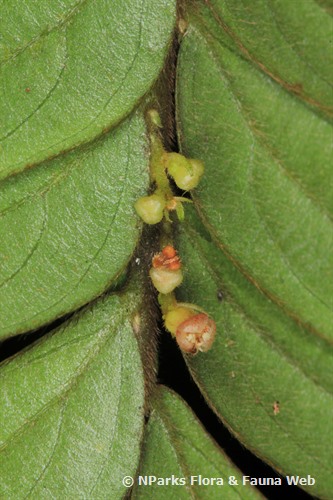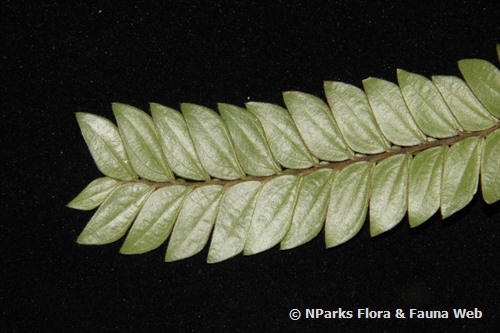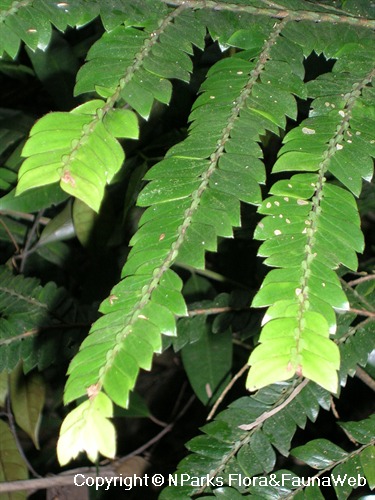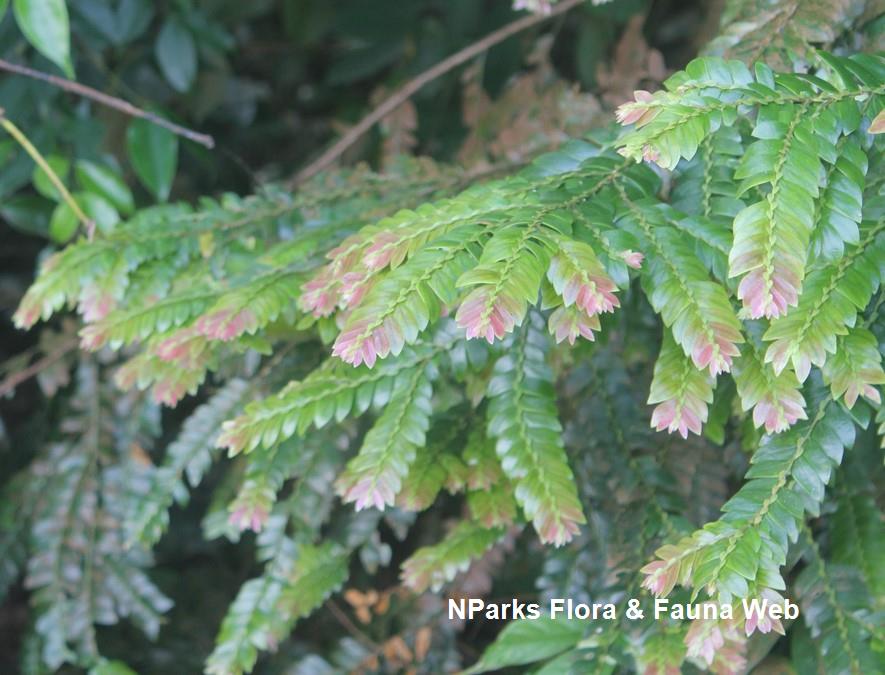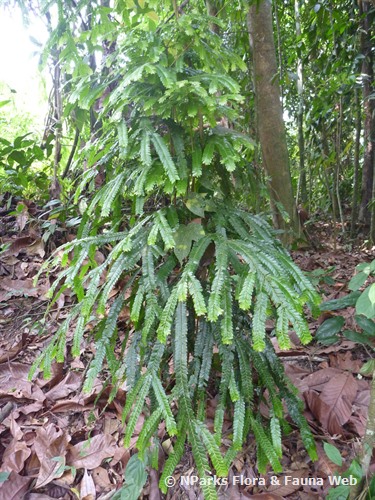
Back
Anisophyllea disticha (Jack) Baill.
| Family Name: | Anisophylleaceae |
| Synonyms: | Anisophyllea rhomboidea Baill., Anisophyllea trapezoidale Baill. |
| Common Name: | Mousedeer Tree, Leechwood, Kayu Pachat, Kayu Ribu Ribu, Pokok Kanchil, Raja Berangkat, Balam Ayam, Rambai Ayam |
Name
Classifications and Characteristics
| Plant Division | Angiosperms (Flowering Seed Plants) |
|---|---|
| Plant Growth Form | Shrub, Tree (Shrubby (1m-5m), Small (6m-15m)) |
| Lifespan (in Singapore) | Perennial |
| Mode of Nutrition | Autotrophic |
| Plant Shape | Irregular |
| Maximum Height | 7.6 m |
Biogeography
| Native Distribution | Sumatra, Lingga Island, Peninsular Malaysia, Singapore, and Borneo |
|---|---|
| Native Habitat | Terrestrial (Primary Rainforest, Secondary Rainforest, Freshwater Swamp Forest) |
| Preferred Climate Zone | Tropical |
| Local Conservation Status | Native to Singapore (Least Concern (LC)) |
Description and Ethnobotany
| Growth Form | It is a dioecious tree up to 7.6 m tall, with droopy branches arranged in whorls. |
|---|---|
| Foliage | It has two kinds of alternate, stalkless leaves. Its larger leaves have leaf blades that are rhomboid and 1.3–9 by 0.5–3 cm. They are closely arranged along the lateral sides of branches and touching leaf margins. Its smaller leaves have blades that are lance-shaped and up to 5 mm long. |
| Flowers | Its male flower clusters are up to 7 cm long. The male flowers are up to 2 mm long. Its female flowers are about 2 mm long, and often solitary or occasionally on 2 cm-long flowering shoots. |
| Fruit | Its bright red drupe is drop-shaped and 1.8–2.5 cm long. Its seed is up to 2 cm long, with about 6–8 grooves. |
| Habitat | It grows in lowland forest, freshwater swamp forest and on granitic sands. |
| Associated Fauna | Its flowers are insect-pollinated. |
| Cultivation | It can be propagated by seed. |
| Etymology | Latin Anisophyllea, unequal leaves, referring to the two kinds of leaves produced by the plant; Latin disticha, two-ranked, probably referring to large leaves on opposite sides on a branch |
| Ethnobotanical Uses | Medicinal: Traditional Medicinal Uses In Asia countries like Indonesia, the plant is used in traditional medicine to treat a wide variety of conditions, such as relieving weariness <1> diarrhoea, dysentery, jaundice, <2> and fatty liver <3>. It is important to note that some therapeutic effects from traditional medicinal uses of plants are not currently supported or verified by scientific research. Timber & Products: Its trunk can be made into walking sticks and shafted weapons. |
Landscaping Features
| Landscaping | It is suitable for shaded and confined areas in parks. It also bears attractive rhomboid leaves and bright red coloured fruits. |
|---|---|
| Desirable Plant Features | Ornamental Foliage, Ornamental Fruits |
| Landscape Uses | Parks & Gardens, Small Gardens, Interiorscape/ Indoor Plant |
Fauna, Pollination and Dispersal
| Pollination Method(s) | Biotic (Fauna) |
|---|---|
| Seed or Spore Dispersal | Biotic (Fauna) |
Plant Care and Propagation
| Light Preference | Semi-Shade, Full Shade |
|---|---|
| Water Preference | Moderate Water |
| Plant Growth Rate | Moderate |
| Rootzone Tolerance | Moist Soils, Well-Drained Soils, Fertile Loamy Soils |
| Maintenance Requirements | Moderate |
| Propagation Method | Seed |
Foliar
| Foliage Retention | Evergreen |
|---|---|
| Mature Foliage Colour(s) | Green |
| Prominent Young Flush Colour(s) | Red |
| Foliar Type | Simple / Unifoliate |
| Foliar Arrangement Along Stem | Alternate |
| Foliar Attachment to Stem | Sessile |
| Foliar Shape(s) | Non-Palm Foliage |
| Foliar Venation | Pinnate / Net |
| Foliar Margin | Entire |
| Leaf Area Index (LAI) for Green Plot Ratio | 4.5 (Shrub & Groundcover - Dicot) |
Floral (Angiosperm)
| Flower & Plant Sexuality | Unisexual Flowers , Dioecious |
| Flower Grouping | Cluster / Inflorescence |
|---|
| Flower Location | Terminal |
Fruit, Seed and Spore
| Mature Fruit Colour(s) | Red |
|---|---|
| Fruit Classification | Simple Fruit |
| Fruit Type | Fleshy Fruit , Non-Accessory Fruit |
References
| References | <1> Nor-Ezzawanis, A.T. (2018). Anisophyllea. In: Kiew, R., Chung, R.C.K., Saw. L.G. & Soepadmo, E. (eds). Flora of Peninsular Malaysia, Ser. 2, Seed Plants, vol. 7, pp. 18-19. Malaysia: Forest Research Institute Malaysia. <2> Plant Resource Of Southeast Asia (continuously updated). Anisophyllea (PROSEA) - PlantUse English. https://uses.plantnet-project.org/en/Anisophyllea_(PROSEA). Accessed from 24 October 2023. <3> Supiandi, M.I., Mahanal, S., Zubaidah, S., Julung, H. & Ege, B. (2019). Ethnobotany of traditional medicinal plants used by Dayak Desa Community in Sintang, West Kalimantan, Indonesia. Biodiversitas 22(5): 1264-1270. |
|---|
Image Repository
Others
| Master ID | 375 |
|---|---|
| Species ID | 1671 |
| Flora Disclaimer | The information in this website has been compiled from reliable sources, such as reference works on medicinal plants. It is not a substitute for medical advice or treatment and NParks does not purport to provide any medical advice. Readers should always consult his/her physician before using or consuming a plant for medicinal purposes. |

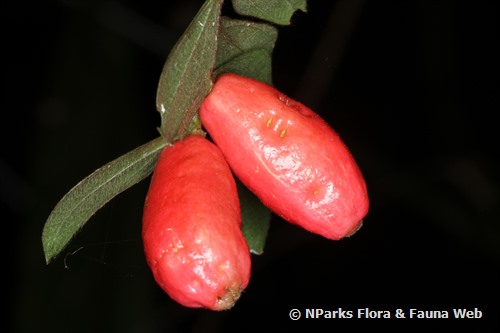
_lowres.jpg)
_lowres.jpg)
